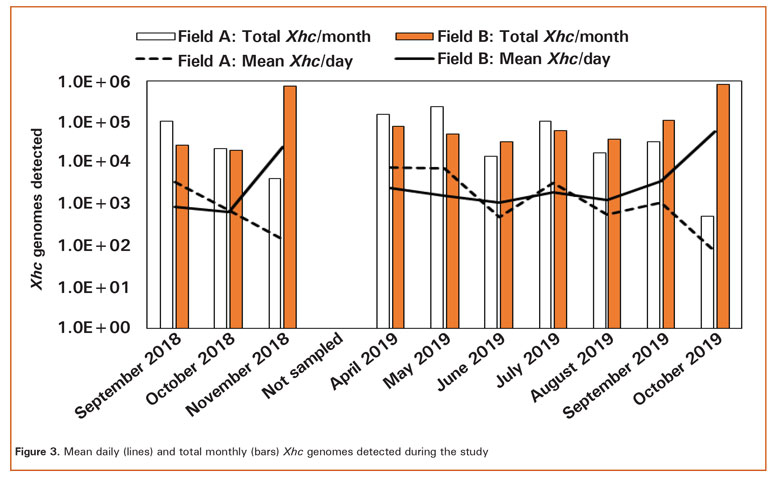|
Click to listen to this article
|
Insights into Bacterial Blight Epidemiology
By Jeremiah Dung and Jeness Scott, Central Oregon Agricultural Research and Extension Center, Oregon State University
A research study is paving the way for the development of a forecasting model to help growers manage bacterial blight in carrot seed crops.

Bacterial blight of carrot is a common disease and is caused by the plant pathogenic bacterium Xanthomonas hortorum pv. Carotae (Xhc). Infection results in irregular, chlorotic areas on leaves, petioles and stems that turn into water-soaked, necrotic lesions and blighted leaves.
The Xhc pathogen can be transmitted by infected seed, and the seed-borne nature of Xhc makes it a major concern for Oregon’s hybrid carrot seed industry. In seed production systems, bacterial blight can result in blighted umbels (Fig. 1), causing reduced seed yield, lower germination rates of harvested seed, and infected seed.
Several species of Xanthomonas, including Xhc, are considered epiphytes, meaning that they can survive and multiply on the leaves, stems, flowers and/or fruits of plants, often without causing symptoms. In the case of Xhc, the bacterial blight pathogen can persist and reproduce on carrot leaves epiphytically and asymptomatically, with disease developing only after large populations are attained on foliage (over 1 million colony-forming units per gram of leaf tissue).
Additionally, many epiphytic bacteria are subject to and dispersed in air currents through various mechanisms. Consequently, carrot seed crop canopies can be potential sources of airborne Xhc in naturally occurring aerosols. Previous studies have collected Xhc in air sampled during carrot seed harvest and combining events, demonstrating the potential for short- and long-distance movement of the pathogen in dusts and aerosols generated during cultural practices.

Field Research
The biennial nature of carrot seed production requires at least 13 months from planting to harvesting, resulting in a potential “green bridge” that facilitates Xhc survival from year to year. Consequently, the crop is potentially exposed to bacterial blight inoculum from the seedling stage until harvest.
We conducted a field study to quantify and characterize the amount and timing of airborne Xhc throughout the carrot seed production season and identify weather factors that contribute to airborne Xhc in and around carrot seed fields.
Hirst-type Burkard seven-day volumetric spore samplers were used to sample air continuously in two carrot seed-to-seed fields which were located approximately 6.4 km apart and intended for harvest in 2019. Air samples were collected from the beginning of stand establishment (August 2018) through November 2018 and from April 2019 through harvest (October 2019). Fields were not sampled from December 2018 through March 2019 due to the inability of accessing and maintaining the spore samplers located at each field site.
Samples from Burkard spore traps were separated into daily segments and DNA was extracted from each sample. The number of Xhc genomes present in each air sample was quantified using a previously published quantitative polymerase chain reaction (qPCR) assay specific to Xhc.
During the 2018-19 season, air samples were collected on a total of 273 and 289 days in two fields, and Xhc was detected on 223 (82 percent) and 245 (85 percent) sampling days (Fig. 2). On average, 2,600 and 7,000 Xhc genomes were detected on a given day, and a maximum of up to 730,000 Xhc genomes were detected on a single day (Fig. 3).

To identify factors most significantly correlated with airborne levels of Xhc, principal component analysis was conducted using weather data collected by the MRSO AgriMet Weather station located at the Central Oregon Agricultural Research and Extension Center in Madras, Oregon. Principal component analysis identified temperature (daily mean, maximum and minimum air and soil temperatures), wind (wind speed, direction and run) and factors related to moisture (daily precipitation, relative humidity and dew point) as being associated with Xhc in air samples.
Growing conditions in the high desert, where carrot seed is frequently produced, are often characterized by sunny and dry days, windy afternoons and cool nights, which may contribute to the dispersal of airborne Xhc in and around carrot seed fields.
This study provides a foundation for the development of a forecasting model to aid in the management of bacterial blight in carrot seed crops. By identifying weather factors and cultural practices that promote the reproduction or dispersal of Xhc, growers can potentially time their bactericide applications to occur prior to the development of favorable conditions or practices, maximizing the protective effect of copper-based bactericides.
Authors’ note: This work was supported by the USDA National Institute of Food and Agriculture, through the Specialty Crops Research Initiative Project grant no. 2020-51181-32154 and the Western Integrated Pest Management Center project ID 1616. Additional funding was also received from the Agricultural Research Foundation.

